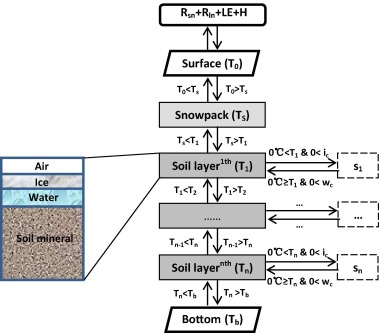Snowmelt modeling
This unit introduces current state-of-the-art of snow-melt modeling in Earth System, numerical weather prediction, climate and hydrological models. Snow and snow-melt modeling is of importance for various applications like river forecasts, water management, as the snow-pack acts as a temporary storage. Due to its high albedo, melting and sublimation snow also links to the energy cycle. Since snow accumulates over winter or shorter time pollutants deposited on the snow accumulate over time and may be a burden for rivers during snow-melt and/or water quality.
Goals
The goal of this unit is to introduce various state-of-the-art approaches to snow-melt modeling to evaluate for which application purposes they are suitable.
After successful completion of this unit students will be able to
- Explain the importance of modeling
- Explain and identify approaches to snow- and snow-melt modeling
- Discuss advantages and disadvantages of different snow modeling approaches
- Evaluate snow model concepts and and results from snow modeling
Students’ tasks
- Read Dingman’s Chapter 5.7 to 5.7.4 (included)
- Watch this video of a worked problem
- Fill out the questionnaire
- Solve the problems assigned to your class level in this Unit 9 Applications task sheet and submit your scanned solutions by Thursday 2359 Alaska time
Optional reading for graduate students
Snow albedo parameterization
Multi-layer snow model description and results
FAQ:
Q: In 5.7.2.3. in Eq. (5.72), what did the book mean by “restricted” factor? Just that M never changes?
A: This empirical parameter, M, serves to reduce the melting rate when the air temperature is below freezing. It is a conceptual approach to take care of the effect that at below freezing air temperatures, some of the energy has to offset the impact of the cold air above the snowpack on the temperature profile in the snowpack. Consequently, the snowpack melts at a lower rate than one would expect by looking at the energy balance alone. In other words, the term MrTa is a parameterization for the heat flux into the snow. This flux is negative at temperatures below and positive at temperatures above freezing.
© 2019 Nicole Mölders | All rights reserved
